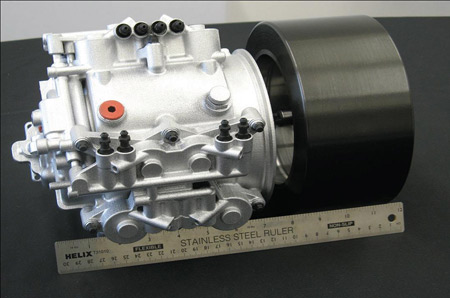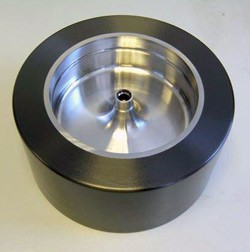Formula One could be on to something big. Next year all teams will be allowed to capture the energy that their cars produce under braking, and then re-use that energy at opportune moments, like passing on a straight.
It's really a hybrid system, but they don't call it that. They call it a Kinetic Energy Recovery System (KERS).
The best part of the new regulations is that they do not specify what kind of regenerative energy system the teams have to use. It seems pretty likely that Toyota and Honda will go with a battery-electric hybrid system, since that's the kind of technology they sell in their showrooms. But Formula One is also going to become the testing grounds for a completely different kind of hybrid system that does not use batteries.
John McElroy is host of the TV program "Autoline Detroit". Every week he brings his unique insights as an auto industry insider to Autoblog readers. Follow the jump to continue reading this week's editorial.

It's called a flybrid, a combination of flywheel and hybrid. Rather than capture and store braking energy as electricity in batteries as most hybrids do, it stores that energy mechanically in the form of a spinning flywheel. You know those toy cars you push along the carpet so the wheels will get an internal flywheel spinning, then let it go and watch it scoot across the floor? It's the same idea, only fancier.
 The Formula One version gets the flywheel spinning when the brakes are applied, thanks to a CVT, which acts as a go-between for the flywheel, the gearbox and the differential. During braking the car is slowed down by the energy that's mechanically diverted into the flywheel and the effort that goes into getting it spinning. As a result, it spins with ferocious intensity. The flywheel, which is a small cylinder made of carbon and steel that only weighs about ten pounds, is encased in a vacuum and spins up to 64,500 rpm. To express that in more impressive terms, the outer edge of the flywheel is traveling at Mach 3.3!
The Formula One version gets the flywheel spinning when the brakes are applied, thanks to a CVT, which acts as a go-between for the flywheel, the gearbox and the differential. During braking the car is slowed down by the energy that's mechanically diverted into the flywheel and the effort that goes into getting it spinning. As a result, it spins with ferocious intensity. The flywheel, which is a small cylinder made of carbon and steel that only weighs about ten pounds, is encased in a vacuum and spins up to 64,500 rpm. To express that in more impressive terms, the outer edge of the flywheel is traveling at Mach 3.3!
To tap into that power, a clutch engages the flywheel with the CVT, which feeds through the gearbox into the differential which turns the axles that drive the tires and wheels.
During the 2009 season, Formula One is regulating how much extra power can be used, and how long it can be used for. Though the rules writers express it in more technical terms, for all practical purposes it's limited to bursts of 80 horsepower that can be used for up to 6.6 seconds, every lap.
But that's what the rules writers want for Formula One. What I find so intriguing about the flybrid is that it can easily be configured to use in everyday vehicles. Indeed, the companies that have developed this system claim it can boost the fuel economy of a vehicle by 27% based on the EPA driving cycle (FTP75). They claim they can offer a hybrid package that is half the size and weight of a battery-based system, at one quarter of the cost. It's also made from fairly common materials that can be readily recycled.
This is a collaborative effort involving three different UK-based companies. The first, appropriately enough, is called Flybrid Systems LLP. It holds two crucial patents that make the system practical: a method to seal the vacuum in the flywheel housing, and a way to contain the flywheel in case of catastrophic failure. This latter point is extremely critical as there's been a couple of reports over the years of engineers being fatally injured when the flywheel systems they were working on failed with explosive consequences. Two transmission companies, Torotrak and Xtrac, are the other partners in this effort.
F1 teams are not required to use a KERS in their cars. But it seems unlikely that anyone will want to give up the chance to use that "push-to-pass" power. We'll have to wait and see what kinds of systems actually show up on the grid next year, but the flybrid people tell me there will be two teams with theirs. Since the principle managers at Flybrid Systems LLP have historical connections with the Renault F1 team, it makes me think that's possibly one of them.
The word out there is that Williams will have a completely different system that uses both a flywheel and batteries. And the Le Mans organizers and ALMS are looking into flybrids, too. So who knows where this is all going?
Not only is the flybrid a fascinating technology, it's an encouraging example of how motor racing can use regulations like KERS to regain its historical role of pushing the technological envelope to point the way to a better automotive future.
Read more about the Flybrid over at John's Journal on Autolinedetroit.tv.
Autoline Detroit
Airs every Sunday at 7:00AM on Speed and 10:30AM on Detroit Public Television.
Autoline Detroit Podcast
Click here to subscribe in iTunes
Last week's show: "Necessary Conclusions"
It's really a hybrid system, but they don't call it that. They call it a Kinetic Energy Recovery System (KERS).
The best part of the new regulations is that they do not specify what kind of regenerative energy system the teams have to use. It seems pretty likely that Toyota and Honda will go with a battery-electric hybrid system, since that's the kind of technology they sell in their showrooms. But Formula One is also going to become the testing grounds for a completely different kind of hybrid system that does not use batteries.
John McElroy is host of the TV program "Autoline Detroit". Every week he brings his unique insights as an auto industry insider to Autoblog readers. Follow the jump to continue reading this week's editorial.

It's called a flybrid, a combination of flywheel and hybrid. Rather than capture and store braking energy as electricity in batteries as most hybrids do, it stores that energy mechanically in the form of a spinning flywheel. You know those toy cars you push along the carpet so the wheels will get an internal flywheel spinning, then let it go and watch it scoot across the floor? It's the same idea, only fancier.
 The Formula One version gets the flywheel spinning when the brakes are applied, thanks to a CVT, which acts as a go-between for the flywheel, the gearbox and the differential. During braking the car is slowed down by the energy that's mechanically diverted into the flywheel and the effort that goes into getting it spinning. As a result, it spins with ferocious intensity. The flywheel, which is a small cylinder made of carbon and steel that only weighs about ten pounds, is encased in a vacuum and spins up to 64,500 rpm. To express that in more impressive terms, the outer edge of the flywheel is traveling at Mach 3.3!
The Formula One version gets the flywheel spinning when the brakes are applied, thanks to a CVT, which acts as a go-between for the flywheel, the gearbox and the differential. During braking the car is slowed down by the energy that's mechanically diverted into the flywheel and the effort that goes into getting it spinning. As a result, it spins with ferocious intensity. The flywheel, which is a small cylinder made of carbon and steel that only weighs about ten pounds, is encased in a vacuum and spins up to 64,500 rpm. To express that in more impressive terms, the outer edge of the flywheel is traveling at Mach 3.3!
To tap into that power, a clutch engages the flywheel with the CVT, which feeds through the gearbox into the differential which turns the axles that drive the tires and wheels.
During the 2009 season, Formula One is regulating how much extra power can be used, and how long it can be used for. Though the rules writers express it in more technical terms, for all practical purposes it's limited to bursts of 80 horsepower that can be used for up to 6.6 seconds, every lap.
But that's what the rules writers want for Formula One. What I find so intriguing about the flybrid is that it can easily be configured to use in everyday vehicles. Indeed, the companies that have developed this system claim it can boost the fuel economy of a vehicle by 27% based on the EPA driving cycle (FTP75). They claim they can offer a hybrid package that is half the size and weight of a battery-based system, at one quarter of the cost. It's also made from fairly common materials that can be readily recycled.
This is a collaborative effort involving three different UK-based companies. The first, appropriately enough, is called Flybrid Systems LLP. It holds two crucial patents that make the system practical: a method to seal the vacuum in the flywheel housing, and a way to contain the flywheel in case of catastrophic failure. This latter point is extremely critical as there's been a couple of reports over the years of engineers being fatally injured when the flywheel systems they were working on failed with explosive consequences. Two transmission companies, Torotrak and Xtrac, are the other partners in this effort.
F1 teams are not required to use a KERS in their cars. But it seems unlikely that anyone will want to give up the chance to use that "push-to-pass" power. We'll have to wait and see what kinds of systems actually show up on the grid next year, but the flybrid people tell me there will be two teams with theirs. Since the principle managers at Flybrid Systems LLP have historical connections with the Renault F1 team, it makes me think that's possibly one of them.
The word out there is that Williams will have a completely different system that uses both a flywheel and batteries. And the Le Mans organizers and ALMS are looking into flybrids, too. So who knows where this is all going?
Not only is the flybrid a fascinating technology, it's an encouraging example of how motor racing can use regulations like KERS to regain its historical role of pushing the technological envelope to point the way to a better automotive future.
Read more about the Flybrid over at John's Journal on Autolinedetroit.tv.
###
Autoline Detroit
Airs every Sunday at 7:00AM on Speed and 10:30AM on Detroit Public Television.
Autoline Detroit Podcast
Click here to subscribe in iTunes
Last week's show: "Necessary Conclusions"


Sign in to post
Please sign in to leave a comment.
Continue